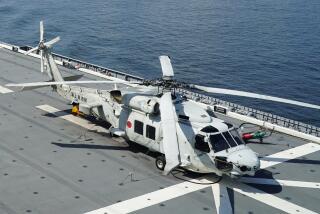Mechanical Failure, Pilot Error Seen as Causes of Apache Crashes
- Share via
WASHINGTON — The recent crashes of two Apache helicopters in Albania were caused by pilot error in one case and an apparent tail rotor failure in the other, Pentagon investigators have tentatively concluded.
The gunship that exploded into flames last week, killing two pilots, went into a rapid spiral in the last moments before the crash, suggesting a failure of the tail rotor, defense officials told The Times. The tail rotor mechanism stabilizes the aircraft.
In the earlier crash, pilots landing at an airport April 26 misjudged distance and came down short of a runway, investigators said. The pilots escaped with only minor injuries.
There is no evidence that electrical power lines, unmarked on U.S. government maps of Albania, were at fault in the second incident, as the White House reported in the first hours after the crash, officials said.
And military leaders do not believe that the apparent mechanical failure in the second case requires any halt in the use of the gunship, officials said.
“There’s no underlying theme in these two,” said one defense official, who asked to remain unidentified.
But the tentative verdict of mechanical failure may raise questions in some quarters about the Apache AH-64, a highly sophisticated tank-buster that has drawn some criticism because of its unusual maintenance needs.
For different reasons, the deployment of the Apaches has been controversial since U.S. Army Gen. Wesley K. Clark, NATO’s supreme commander, informally requested them March 24 as the air war against Yugoslavia began.
Advocates of a more aggressive NATO effort saw them as a way to stop Yugoslav field forces and halt the brutal “ethnic cleansing” of Albanians from Kosovo.
But, facing complex logistical problems, the 24 helicopters did not begin reaching staging areas in northeast Albania until April 21. Critics began pointing to the mission as an example of poor planning by the North Atlantic Treaty Organization in the air war.
Since then, Apache crews have been undergoing intensive training for their high-risk deployment, which will expose them to fire from Serbian ground forces. The pilots who are with the Apaches are the best available, Army officials have said, yet they must undergo further training for a mission that will team them with ground units and aircraft to strike deep within Kosovo, a southern province of Serbia, the dominant republic in Yugoslavia.
Their deployment has been controversial even within the Pentagon. Some high-ranking officials said that their use is not worthwhile because it entails an immense logistical effort and substantial risk of casualties for what may be a fairly modest payoff in destruction of Serbian forces.
The Apache is valuable because of its ability to blast ground forces at great distances, in all weather, with Hellfire missiles, high-explosive rockets and a .30-millimeter nose-mounted machine gun. The helicopter’s pilots use infrared screens and night-vision goggles.
In use since 1983, the $14-million Apache distinguished itself in the 1991 Persian Gulf War, during which it destroyed 500 tanks, 30 air-defense sites, 120 artillery pieces and 50 bunkers, according to Jane’s, the military information publisher.
“It’s the prima donna of the helicopter fleet,” said Greg Seigle of Jane’s.
Yet because of their highly sophisticated avionics, navigation system and other technology, the Apaches needed a large staff of technicians from the manufacturer to keep them in operation during the Iraq war.
Army figures show that there have been 50 serious crashes involving the Apache since it went into service. There have been 14 fatalities, including the latest two.
A report by the General Accounting Office in 1992 found several mechanical problems with the Apache, including faulty rotor blades and night-vision systems.
Even so, defense officials and other analysts say the helicopter’s overall safety record is satisfactory. One defense official noted that a rotor blade failure could be a result of a mistake in installation or maintenance rather than a design flaw.
The investigation of the crashes has been handled by the Army’s air safety unit, based at Ft. Rucker, Ala. Its analyses usually take weeks, and this probe is “still in an early stage,” a defense official said. But officials said the intense public interest could accelerate the process in this case.
More to Read
Sign up for Essential California
The most important California stories and recommendations in your inbox every morning.
You may occasionally receive promotional content from the Los Angeles Times.











